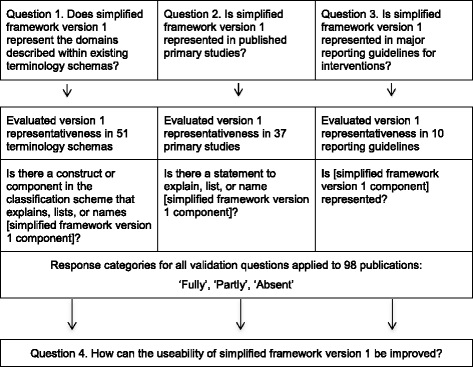AIMD - a validated, simplified framework of interventions to promote and integrate evidence into health practices, systems, and policies
- PMID: 28259155
- PMCID: PMC5336675
- DOI: 10.1186/s12874-017-0314-8
AIMD - a validated, simplified framework of interventions to promote and integrate evidence into health practices, systems, and policies
Abstract
Background: Proliferation of terms describing the science of effectively promoting and supporting the use of research evidence in healthcare policy and practice has hampered understanding and development of the field. To address this, an international Terminology Working Group developed and published a simplified framework of interventions to promote and integrate evidence into health practices, systems, and policies. This paper presents results of validation work and a second international workgroup meeting, culminating in the updated AIMD framework [Aims, Ingredients, Mechanism, Delivery].
Methods: Framework validity was evaluated against terminology schemas (n = 51); primary studies (n = 37); and reporting guidelines (n = 10). Framework components were independently categorized as fully represented, partly represented, or absent by two researchers. Opportunities to refine the framework were systematically recorded. A meeting of the expanded international Terminology Working Group updated the framework by reviewing and deliberating upon validation findings and refinement proposals.
Results: There was variation in representativeness of the components across the three types of literature, in particular for the component 'causal mechanisms'. Analysis of primary studies revealed that representativeness of this concept lowered from 92 to 68% if only explicit, rather than explicit and non-explicit references to causal mechanisms were included. All components were very well represented in reporting guidelines, however the level of description of these was lower than in other types of literature. Twelve opportunities were identified to improve the framework, 9 of which were operationalized at the meeting. The updated AIMD framework comprises four components: (1) Aims: what do you want your intervention to achieve and for whom? (2) Ingredients: what comprises the intervention? (3) Mechanisms: how do you propose the intervention will work? and (4) Delivery: how will you deliver the intervention?
Conclusions: The draft simplified framework was validated with reference to a wide range of relevant literature and improvements have enhanced useability. The AIMD framework could aid in the promotion of evidence into practice, remove barriers to understanding how interventions work, enhance communication of interventions and support knowledge synthesis. Future work needs to focus on developing and testing resources and educational initiatives to optimize use of the AIMD framework in collaboration with relevant end-user groups.
Keywords: Dissemination and implementation; Framework validation; Healthcare quality improvement; Implementation science; Knowledge translation.
Figures
Similar articles
-
Towards a common terminology: a simplified framework of interventions to promote and integrate evidence into health practices, systems, and policies.Implement Sci. 2014 May 1;9:51. doi: 10.1186/1748-5908-9-51. Implement Sci. 2014. PMID: 24885553 Free PMC article.
-
How has the impact of 'care pathway technologies' on service integration in stroke care been measured and what is the strength of the evidence to support their effectiveness in this respect?Int J Evid Based Healthc. 2008 Mar;6(1):78-110. doi: 10.1111/j.1744-1609.2007.00098.x. Int J Evid Based Healthc. 2008. PMID: 21631815
-
Examining the nature of interprofessional practice: An initial framework validation and creation of the InterProfessional Activity Classification Tool (InterPACT).J Interprof Care. 2018 Jul;32(4):416-425. doi: 10.1080/13561820.2017.1408576. Epub 2017 Dec 13. J Interprof Care. 2018. PMID: 29236560
-
Avoiding and identifying errors in health technology assessment models: qualitative study and methodological review.Health Technol Assess. 2010 May;14(25):iii-iv, ix-xii, 1-107. doi: 10.3310/hta14250. Health Technol Assess. 2010. PMID: 20501062 Review.
-
A framework for scaling up health interventions: lessons from large-scale improvement initiatives in Africa.Implement Sci. 2016 Jan 29;11:12. doi: 10.1186/s13012-016-0374-x. Implement Sci. 2016. PMID: 26821910 Free PMC article. Review.
Cited by
-
Organizational supports for knowledge translation in paediatric health centres and research institutes: insights from a Canadian environmental scan.Implement Sci Commun. 2021 May 13;2(1):49. doi: 10.1186/s43058-021-00152-7. Implement Sci Commun. 2021. PMID: 33985591 Free PMC article.
-
Promises and pitfalls in implementation science from the perspective of US-based researchers: learning from a pre-mortem.Implement Sci. 2022 Aug 13;17(1):55. doi: 10.1186/s13012-022-01226-3. Implement Sci. 2022. PMID: 35964095 Free PMC article.
-
What is context in knowledge translation? Results of a systematic scoping review.Health Res Policy Syst. 2024 Apr 29;22(1):52. doi: 10.1186/s12961-024-01143-5. Health Res Policy Syst. 2024. PMID: 38685073 Free PMC article.
-
The Intersection of Rural Residence and Minority Race/Ethnicity in Cancer Disparities in the United States.Int J Environ Res Public Health. 2021 Feb 3;18(4):1384. doi: 10.3390/ijerph18041384. Int J Environ Res Public Health. 2021. PMID: 33546168 Free PMC article. Review.
-
Examining the complementarity between the ERIC compilation of implementation strategies and the behaviour change technique taxonomy: a qualitative analysis.Implement Sci. 2022 Aug 19;17(1):56. doi: 10.1186/s13012-022-01227-2. Implement Sci. 2022. PMID: 35986333 Free PMC article.
References
-
- McKibbon KA, Lokker C, Wilczynski NL, Ciliska D, Dobbins M, Davis DA, Haynes RB, Straus SE. A cross-sectional study of the number and frequency of terms used to refer to knowledge translation in a body of health literature in 2006: a Tower of Babel? Implement Sci. 2010;5:16. doi: 10.1186/1748-5908-5-16. - DOI - PMC - PubMed
-
- Colquhoun H, Leeman J, Michie S, Lokker C, Bragge P, Hempel S, McKibbon KA, Peters GJ, Stevens KR, Wilson MG, et al. Towards a common terminology: a simplified framework of interventions to promote and integrate evidence into health practices, systems, and policies. Implement Sci. 2014;9(1):51. - PMC - PubMed
Publication types
MeSH terms
Grants and funding
LinkOut - more resources
Full Text Sources
Other Literature Sources


